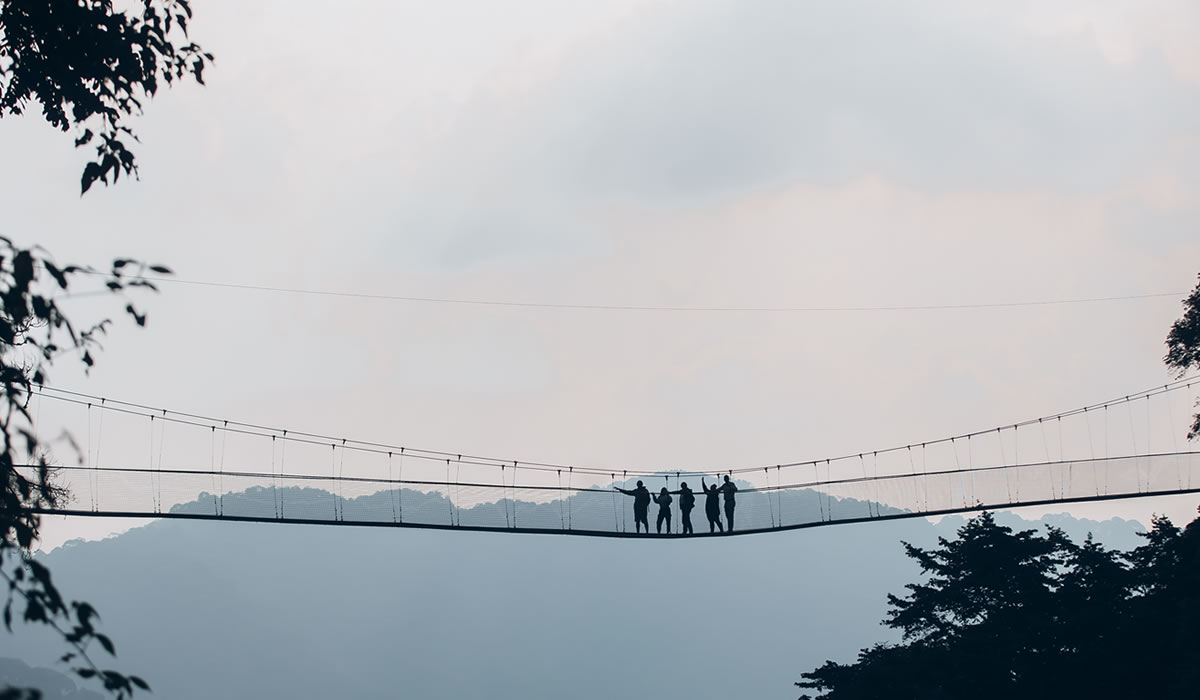The Nyungwe Forest Canopy Walk stands as one of East Africa’s most exhilarating and unique forest experiences, offering visitors an extraordinary perspective of Rwanda’s ancient montane rainforest. Suspended high above the forest floor, this remarkable walkway provides an unparalleled opportunity to explore the forest canopy ecosystem while enjoying breathtaking views across one of Africa’s most pristine wilderness areas. The canopy walk in Nyungwe has become a must-do activity for adventure travelers, nature enthusiasts, and anyone seeking to experience the forest from an entirely different vantage point.

The Engineering Marvel of Nyungwe’s Canopy Walk
The Nyungwe Forest Canopy Walk represents a remarkable feat of engineering designed to minimize environmental impact while maximizing visitor experience. Stretching 160 meters in length and suspended 50 meters above the forest floor, this aluminum and steel suspension bridge ranks among the longest and highest canopy walks in East Africa. The walkway was carefully constructed to blend seamlessly with the natural environment, using materials and techniques that ensure minimal disturbance to the surrounding ecosystem.
The bridge consists of three main sections connected by sturdy platforms that serve as viewing points and rest areas. These platforms, strategically positioned among the forest giants, provide stable areas where visitors can pause to observe wildlife, take photographs, or simply absorb the magnificent forest atmosphere. The entire structure is anchored to massive trees that have stood in this forest for centuries, creating a harmonious integration between human engineering and natural architecture.
Safety remains the paramount concern in the canopy walk’s design and operation. The walkway features secure handrails on both sides, anti-slip surfaces, and weight limitations that ensure structural integrity. Regular inspections and maintenance by qualified engineers guarantee that the bridge meets international safety standards while preserving its minimal environmental footprint.
The Canopy Walk Experience
The canopy walk adventure begins at the Uwinka Visitor Center, where experienced guides provide comprehensive safety briefings and forest ecology orientation. The journey to the canopy walk itself involves a scenic 45-minute hike through the forest’s understory, offering opportunities to encounter various wildlife species and learn about the complex forest ecosystem before ascending to the treetops.
As visitors step onto the suspension bridge, the forest reveals itself from an entirely new perspective. The gentle swaying motion of the walkway, combined with the incredible height, creates an initial sense of exhilaration that gradually transforms into peaceful contemplation as the forest’s majesty unfolds. The experience of walking among the tree crowns, where sunlight filters through the canopy and bird calls echo from all directions, provides an almost spiritual connection to this ancient ecosystem.
The walk typically takes 30 to 45 minutes to complete, though many visitors choose to spend additional time on the viewing platforms, photographing the spectacular scenery or hoping to spot wildlife in the canopy. The pace is entirely flexible, allowing each visitor to fully appreciate this unique experience according to their comfort level and interests.
Weather conditions can dramatically alter the canopy walk experience. On clear days, the views extend far beyond the forest boundaries, revealing rolling hills and distant mountains that showcase Rwanda’s stunning landscape diversity. During misty conditions, the forest takes on an mystical quality as clouds drift through the canopy, creating an ethereal atmosphere that feels like walking through the clouds.
Wildlife and Birdwatching Opportunities
The forest canopy represents one of the richest ecosystems on Earth, and the Nyungwe canopy walk provides unprecedented access to this aerial habitat. From the walkway’s elevated position, visitors have excellent opportunities to observe primate species that spend much of their time in the tree crowns, including various colobus monkeys, blue monkeys, and occasionally chimpanzees moving through their arboreal highways.
Birdwatching from the canopy walk is exceptional, with over 310 bird species recorded in Nyungwe Forest. The elevated position allows for eye-level viewing of species that would otherwise remain hidden in the canopy, including numerous endemic species of the Albertine Rift. Colorful turacos, hornbills, and sunbirds frequently visit the flowering trees near the walkway, while raptors can often be observed soaring at canopy level.
The walkway also provides unique opportunities to observe the forest’s incredible plant diversity from a new perspective. Epiphytes, including orchids, ferns, and bromeliads that live on tree branches and trunks, become easily visible from the elevated walkway. The complex vertical structure of the forest, from ground level to emergent tree crowns, reveals itself in remarkable detail from this aerial vantage point.
Best Times to Visit and Seasonal Considerations
The optimal timing for the Nyungwe canopy walk depends on weather preferences and wildlife viewing priorities. The dry seasons, from June to September and December to February, offer the most comfortable walking conditions with clearer skies and reduced rainfall. During these periods, visibility is typically excellent, and the walkway remains dry and less slippery.
However, the rainy seasons from March to May and October to November provide their own unique advantages. The forest becomes incredibly lush and vibrant, with enhanced bird activity and more frequent primate sightings as animals move about during cooler, overcast conditions. The dramatic interplay between mist, clouds, and forest canopy during these periods creates spectacular photographic opportunities, though visitors should be prepared for potentially wet conditions.
Early morning visits, typically starting between 8:00 and 9:00 AM, offer the best wildlife viewing opportunities as many species are most active during cooler morning hours. The quality of light during morning hours also provides optimal conditions for photography, with softer lighting that beautifully illuminates the forest canopy.
Practical Information and Preparation
The canopy walk experience is included in the general park entrance fee, making it an accessible addition to any Nyungwe Forest visit. However, advance booking through the Rwanda Development Board or authorized tour operators is recommended, especially during peak tourist seasons. The activity is suitable for most fitness levels, though visitors should be comfortable with heights and able to walk moderate distances on potentially uneven forest trails.
Essential preparation includes wearing comfortable, closed-toe shoes with good grip, as forest paths can be slippery and uneven. Lightweight, quick-dry clothing is recommended, along with a light rain jacket regardless of the season due to the forest’s unpredictable weather patterns. A small daypack for water, snacks, and camera equipment enhances the experience, though heavy bags should be avoided for safety and comfort reasons.
Photography enthusiasts should bring cameras with good zoom capabilities to capture distant wildlife and landscape views. Binoculars significantly enhance wildlife viewing opportunities, particularly for birdwatching and observing distant primate movements. However, all equipment should be securely attached to prevent dropping items from the elevated walkway.
Conservation Impact and Community Benefits
The canopy walk serves as both an educational tool and a conservation funding mechanism for Nyungwe Forest National Park. Revenue generated from tourism activities, including the canopy walk, directly supports forest protection initiatives, anti-poaching efforts, and wildlife research programs. This sustainable tourism model demonstrates the economic value of forest conservation while providing visitors with unforgettable experiences.
Local communities benefit significantly from canopy walk tourism through employment opportunities as guides, porters, and support staff. Many community members have received specialized training in forest ecology, safety procedures, and visitor services, creating career paths that depend on forest conservation rather than resource exploitation.
The educational aspect of the canopy walk experience helps raise awareness about montane forest ecosystems and their global importance. Visitors gain firsthand understanding of forest complexity, biodiversity, and conservation challenges, often becoming advocates for forest protection long after their visit concludes.
Combining the Canopy Walk with Other Nyungwe Activities
The canopy walk integrates seamlessly with other Nyungwe Forest activities, creating comprehensive forest experiences that maximize visitor satisfaction and conservation impact. Many visitors combine the canopy walk with chimpanzee tracking, bird watching tours, or forest hiking trails to gain multiple perspectives of this remarkable ecosystem.
The proximity of various trailheads to the canopy walk starting point makes it easy to explore different forest areas within a single visit. The Igishigishigi Trail, Imbaraga Trail, and Umuyove Trail all offer unique forest experiences that complement the aerial perspective provided by the canopy walk.
The Nyungwe Forest Canopy Walk represents far more than just an adventure activity, it provides a transformative experience that connects visitors with one of Africa’s most important forest ecosystems. This remarkable walkway offers unparalleled access to the forest canopy while supporting crucial conservation efforts and local community development. Whether you’re seeking adventure, wildlife viewing, photography opportunities, or simply a unique way to experience nature, the canopy walk in Nyungwe Forest delivers an unforgettable experience that highlights the incredible beauty and importance of Rwanda’s montane rainforest heritage.

